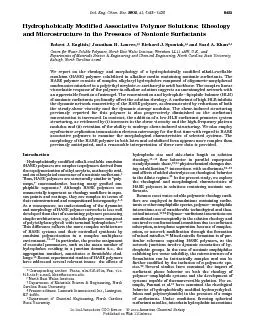

CorrespondingauthorPhone9195154519Fax9195153465emailkhaneosncsueduNorthEastWalesInstituteDepartmentofMaterialsScienceEngineeringNorthCarolinaStateUniversityPresentaddressLexmarkIn ID: 849153
Download Pdf The PPT/PDF document "HydrophobicallyModifiedAssociativePolyme..." is the property of its rightful owner. Permission is granted to download and print the materials on this web site for personal, non-commercial use only, and to display it on your personal computer provided you do not modify the materials and that you retain all copyright notices contained in the materials. By downloading content from our website, you accept the terms of this agreement.
1 HydrophobicallyModifiedAssociativePolyme
HydrophobicallyModifiedAssociativePolymerSolutions:RheologyandMicrostructureinthePresenceofNonionicSurfactantsRobertJ.English,JonathanH.Laurer,RichardJ.Spontak,andSaadA.Khan*CentreforWaterSolublePolymers,NorthEastWalesInstitute,WrexhamLL112AW,U.K.,andDepartmentsofMaterialsScience&EngineeringandChemicalEngineering,NorthCarolinaStateUniversity,Raleigh,NorthCarolina27695Wereportontherheologyandmorphologyofahydrophobicallymodifiedalkali-swellableemulsion(HASE)polymersolubilizedinalkalinemediacontainingnonionicsurfactants.TheHASEpolymerconsistsofcomplexalkylarylhydrophobescomposedofoligomericnonylphenolcondensatesattachedtoapoly(ethylacrylate--methacrylicacid)backbone.Thecomplexlinearviscoelasticresponseofthepolymerinalkalinesolutionsuggestsanunentanglednetworkwithanappreciablefractionofmicrogel.Theconcentrationandhydrophilelipophilebalance(HLB)ofnonionicsurfactantsprofoundlyaffectthesolutionrheology.AsurfactantofhighHLBinhibitsthedynamicnetworkconnectivityoftheHASEpolymer,asdemonstratedbyreductionsofboththesteady-shearviscosityandthedynamicstoragemodulus.Theshear-inducedstructuringpreviouslyreportedforthispolymerisalsoprogressivelydiminishedasthesurfactantconcentrationisincreased.Incontrast,theadditionofalow-HLBsurfactantpromotessystemstructuring,asevidencedby(i)increasesintheshearviscosityandthehigh-frequencyplateaumodulusand(ii)retentionoftheabilitytoundergoshear-inducedstructuring.Wealsoemploycryofracture-replicationtransmissionelectronmicroscopyforthefirsttimewithregardtoHASEassociativepolymerstoexaminethemorphologicalcharacteristicsofselectedsystems.ThemorphologyoftheHASEpolymerinbothlatexandsolubilizedformappearsmorecomplexthanpreviouslyanticipated,andareasonableinterpretationofthesenewdataisprovided.Hydrophobicallymodifiedalkali-swellableemulsion(HASE)polymersarecomplexterpolymersderivedfromthecopolymerizationofethylacrylate,methacrylicacid,andanethoxylatedmacromerofanonionicsurfactant.Thus,HASEpolymersarestructurallysimilartoªpoly-soaps,ºmacromoleculesbearingmanygraftedam-phiphilicsegments.AlthoughHASEpolymersarecommerciallyimportantasrheologymodifiersinaque-ouspaintsandcoatings,theyarecomplexintermsoftheirmicrostructuralandcompositionalheterogeneity.Asaconsequence,anunderstandingofthedynamicsandmorphologyofHASEpolymernetworksislesswelldevelopedthanthatofassociatingpolymerspossessingsimplerarchitectures,e.g.,telechelicpolymerscomposedofpoly(ethyleneglycol)withterminalhydrophobes.ThisdifferencereflectsthemorecomplexarchitectureofHASEsystemsandtheircontrolledsynthesisbyemulsionpolymerizationinacomplexmultiphaseInparticular,thepreciseassignmentofessentialparameters,suchasthemeannumberofhydrophobesresidinginajunctiondomain(i.e.,theaggregationnumber),constitutesaformidablechal-RecentexperimentalstudiesofHASEpolymershaveaddressedseveralrelevantissues:theeffectsofhydrophobesizeandside-chainlengthonsolutionflowbehaviorinparallelsuperposedsteady/dynamicshear,physicochemicalchangesdur-ingsolubilization,interactionswithsurfactants,andeffectsofaddedelectrolytesonrheologicalbehaviorinthediluteregime.Inthepresentstudy,weexploretherheologicalandmorphologicalcharacteristicsofHASEpolymersinsolutionscontainingnonionicsur-Becausemostwater-solublepolymericrheologymodi-fiersareemployedinformulationscontainingsurfac-tantsorotheramphiphilicspecies,polymerinteractionsareofconsiderabletechnologicalandtheo-reticalinterest.surfactantinteractionsaremanifestedmacroscopicallyinthesolutionrheologyandcaninvolveconformationaltransitionsduetosurfactantadsorption,microphaseseparationbecauseofcomplex-ation,ornetworkmodificationthroughtheformationofmixedmicelles.Mixed-micelleformationisofpar-ticularrelevanceregardingHASEpolymers,asthenetworkjunctionsinvolvedynamicassociationofhy-drophobicgroups.Inthecaseofnonionicamphiphilesexhibitinglowwatersolubility,themicrostructureofaformulationcanbeintrinsicallycomplexandcanbefurthermodifiedbytheinclusionofapolymericspe-Severalstudieshaveexaminedtheimpactofsurfactantphasebehavioronboththerheologyofamphiphilesystemsandthedevelopmentofsystemscapableofthermoreversiblegelation.Forex-ample,Panmaietal.haveexaminedtherheologicalbehaviorofhydrophobicallymodifiedhydroxyethylcel-luloseandpoly(acrylamide)inthepresenceofarangeofsurfactants.Underconditionsfavoringsphericalsurfactantmicelles,interchainhydrophobicinteractions *Correspondingauthor:Phone,919-515-4519;Fax,919-515-3465;e-mail,khan@eos.ncsu.edu.NorthEastWalesInstitute.DepartmentofMaterialsScience&Engineering,NorthCarolinaStateUniversity.Presentaddress:LexmarkInternationalInc.,Lexington,KY40550.DepartmentofChemicalEngineering,NorthCarolinaStateUniversity.Ind.Eng.Chem.Res.10.1021/ie020409sCCC:$22.002002AmericanChemicalSocietyPublishedonWeb11/16/2002 areeffectivelyscreenedathighsurfactantconcentra-
2 tions.Theviscosity,however,remainsunchan
tions.Theviscosity,however,remainsunchangedunderconditionsfavoringworm-orrodlikemicelles.Kaczmarskietal.haveexploredtheinteractionofseveralassociatingpolymersinthepresenceofbothsodiumdodecylsulfate(SDS)andanoctylphenolethoxy-late.Thenonionicsurfactantpromotesstructuringofthesysteminthepresenceofhydrophobicallymodifiedethoxylateurethane(HEUR)polymerswithlargeter-minalhydrophobes.WhileDeguchietal.haveexam-inedthegelationofcholesterol-modifiedpullulaninthepresenceofSDS,Loyenetal.haveinvestigatedthethermoreversiblegelationofhydrophobicallymodifiedpoly(acrylicacid)sinthepresenceoflinearalcoholethoxylates.InteractionsofaHASEpolymerwithnonionicsurfactantsisalsothesubjectofthepresentstudy,inwhichalkylphenolethoxylatesofdifferentlipophilebalance(HLB)andvastlydifferentdegreesofaqueoussolubilityareemployed.Insimilarfashion,Candauandco-workershaverecentlystudiedtheinteractionofhydrophobicallymodifiedpoly(acry-lamide)swithsurfactantsandreportthattheam-phiphile-inducedchangeinlowshearviscosityisat-tributabletomodifieddynamicsofthetransientnetwork.Thismodification,inturn,reflectstheformationofmixedjunctiondomainsthatincorporatethesurfactantandpolymer-boundhydrophobes.Inthiswork,weseektoelucidatetheeffectofsurfactantphasebehavioronthemechanismbywhichahydrophobicallymodifiedpolymerofrelativelycomplexmoleculararchitectureinteractswithsurfactantmolecules.Thedatareportedherearediscussedinlightofrecenttheoreticalconsid-erationsofassociatingpolymersystems,andsuitablecomparisonswithotherclassesofwater-bornepolymersexhibitingtransientassociationsareprovided.ExperimentalSectionA.Materials.ThehydrophobesoftheHASEpolymerexaminedhere(depictedinFigure1)consistedofoligomericcondensatesofnonylphenol,withthemajorhydrophobiccomponentbeingthebis-nonylphenylmoi-ety.Themeandegreeofethoxylationinthemacromer80,andtheweightfractionsofethylacrylate,methacrylicacid,andmacromeremployedinthepoly-mersynthesiswere0.4,0.4,and0.2,respectively.Fulldetailsoftheemulsionpolymerizationusedtosynthe-sizethispolymerwerepreviouslydetailed.TheHASElatexwaspreparedat30wt%solidsunderªstarvedfeedºconditions.RecentanalysisofHASEpolymerspreparedinthismannerbyhigh-field(400MHz)NMRspectroscopyrevealedthatthefractionsofmonomericresiduesinthepolymerwerecomparabletotheindividualmonomerfractionsinthemonomerfeedmixture.FractionationofHASEpolymersinaseparatehowever,indicatedtheexistenceofconsiderablecompositionalheterogeneity,asevidencedbyanunequaldistributionofmacromerthroughoutthechainpopula-MolecularweightdeterminationofHASEpolymerswasperformedbyconventionalGPCanalysis.Nonaque-ousGPCofHASEpolymersinpolarsolventssuchasdimethylformamidewasriddledwithproblemsarisingfromnonstericexclusionofthepolymerfromtheporesofthestationaryphase,whereasaqueousGPCwasadverselyaffectedbysupramolecularchainaggrega-Toovercomethesecomplications,theester/urethanelinkagesoftheHASEpolymerweresubjectedtoalkalinehydrolysis,whichyieldsacopolymerofsodiumacrylate/methacrylatethatisamenabletochar-acterizationbyaqueousGPC.PrioranalysisofHASEpolymerspreparedinsimilarfashiontotheoneinves-tigatedinthepresentstudysuggestedthatisabout250000.BecausethepolymerformulashowninFigure1correspondstoamacromermolefractionofthemeannumberofhydrophobes(ªstickersº)perchainwasestimatedtobe15.Dilutesolutionviscometryrevealedthattheintrinsicviscosity,[],oftheHASEpolymerwas4.8dLgat25ÉCin0.05MNaClatpH9.TheHASEpolymerlatexwaspurifiedbydialysis(usingaSpectropore7cellulosicmembranewithacutoff50000)toremoveserumelectrolyteandexcessanionicstabilizer.ThenonionicsurfactantsemployedhereweresuppliedbyUnionCarbide(nowDow):TergitolNP6,anonylphenolethoxylatewithameandegreeofethoxylationof6[NP6],andTergitolNP10,anonylphenolethoxylatewithameandegreeofethoxy-lationof10[NP10].Bothsurfactantswereusedwithoutfurtherpurification.B.Formulations.Thepolymerlatexwasdissolvedinaqueous2-amino-2-methyl-1-propanol(AMP)ataconcentrationof0.006molofamine/gofpolymer,yieldingapHof9.Sampleswerepreparedataconstantionicstrength(0.05MNaCl)bycombiningtherequisiteamountsofpurifiedlatex;distilled/deionizedwater;0.5MNaCl;1.0MAMP;and,whereappropriate,nonionicsurfactant.TherheologyoftheHASEpolymerintheabsenceofsurfactantwasinvestigatedatpolymerconcentrationsbetween0.4and1.2gdL.ThepolymerconcentrationinsolutionsconsistingofNP6andNP10washeldconstantat0.6and1.0gdL,respectively.TheconcentrationofNP6wasvariedfrom0.05to1.5g,andtheconcentrationofNP10rangedfrom0.1to1.1gdL.Allsampleswerecentrifuged(2500rpmfor5min)toremoveentrainedairandsubsequentlyallowedtositforseveraldayspriortorheologicalC.Rheology.RheologicaltestswereperformedinsteadyanddynamicshearusingaRheometricsScien-tificDSRcontrolled-stressrheometerequippedwithappropriatecone-and-plateandconcentriccylinderge-ometries.Steady-sheardataatlowstrainrates()werederivedfroms
3 equentialcreepexperiments,thusensuringth
equentialcreepexperiments,thusensuringthatthedurationofeachtestwassufficienttoattainasteadystrainrate.High-frequency)dynamicdata,expressedintermsofthedynamicstorageandlossmoduli(,respectively),were Figure1.IdealizedchemicalstructureoftheHASEpolymerexaminedinthepresentstudy.Thehydrophobesconsistofamixtureofoligomericcondensatesofnonylphenol,withthemajorcomponentbeingthebis-nonylphenylmoiety.Ind.Eng.Chem.Res.,Vol.41,No.25,2002 obtainedusingaconi-cylindergeometryonaRheomet-ricsScientificRMS800controlled-strainrheometer.Allexperimentswereconductedat250.1ÉC.Thesteady-shearresponseofthepolymer/surfactantsystemswassensitivetoshearhistory,therebynecessitatingtheuseofpresheartoobtainreproducibledata.Applicationofashearstresssufficienttogenerateastrainrateofeffectivelyeliminatedshearhistoryeffects.Pre-shearingwasperformedfor180s,followedbyarestperiodof120s,priortothestartofeachsteady-shearexperiment.Solventevaporationwaspreventedbycoatingtheexposededgesofatestsolutionwithathinlayeroflow-viscositypoly(dimethylsiloxane)fluid(DowCorningDC200,10cS).D.Microscopy.Cryofracture-replicationtransmis-sionelectronmicroscopy(TEM),alsoknownasfreezefractureTEM(althoughcareisexercisedtoavoidcooling-inducedcrystallization),wasperformedtovisualizethemicrostructureoftheHASE/surfactantsolutionspreparedhere.Asmalldropofsolutionwasgentlyplacedinthewellofabrasssampleholdersothatthemeniscusextendedbeyondthetopofthewell.Theassemblywasrapidlyplungedintoliquidethanecooledbyliquidnitrogentoinducesamplevitrification,andthentransferredunderliquidnitrogentoaprevi-ouslycooledbrassbase,whichwassubsequentlyin-sertedintothespecimenchamberofaJEOLJFD-9000Ccryofracture-replicationunitmaintainedat170ÉCandca.10Torr.Oncethermalequilibrationwasachieved,thespecimenwasfracturedwithamicrotomeblade,andthefreshfracturesurfacewasfirstlightlyetched,shadowedwithPt/Catanangleof45ÉandthenstabilizedwithCdepositedat90Éoffthehorizontal.ResultantreplicaswerecleanedinsuccessivewaterbathsandimagedonaZeissEM902electronspectro-scopicmicroscopeoperatedat80kVinzero-lossmode0eV).Negativesweredigitizedat600dpiforpresentationpurposes.ResultsandDiscussionA.LinearViscoelasticResponseoftheHASEThelinearviscoelasticresponseoftheHASEpolymersolutionsintheabsenceofaddedsurfactantistypifiedbythedataprovidedinFigure2,wherethefrequencyspectraofthecomplexviscosity(*)anddynamicmoduli()aredisplayed.Thesedataarereminiscentofareversiblenetworkwhereininter-chaininteractionsaretransient,inwhichcasethesystemdoesnotbehaveasaphysicalgel.Thatis,atransitionoccursfromanelastic-dominatedresponse()athighfrequencies(1rads)toaviscous-dominatedresponseatlowerfrequencies.Examplesofsystemsexhibitingsimilarviscoelasticbehaviorincludesolutionsofahydrophobicallymodifiedgalactomannanandpoly(vinylalco-Thedynamicsofsuchatransientnetworkcanbedescribedintermsofaterminalrelaxationtime,,thatisgovernedbyboththekineticsofhydro-phobicdisengagementandthemeannumberofhydro-phobesonachainforcomb(graft)copolymers.procedureshavebeenestablishedtoascertainfromthefrequencydependenceofthedynamicInthepresentcase,canbeconve-nientlyestimatedfromthereciprocalofwiththemaximuminthelossmodulus,,thatoccursattheonsetoftheelasticplateauregion.Thecon-nectivityofthenetworkcanbeexpressedasaplateauorpseudoequilibriummodulus,,givenbythevaluecorrespondingto.Alternatively,canbecalculatedbyintegratingacrossthemaximumasfollows:Theupperlimitofthisintegrationmustbesettoexcludetheonsetofthetransitionzoneforconcentratedpolymersystemssuchasmelts.Althoughthecalculatedfromtheaboveapproachesdifferslightly,theyexhibitsimilardependenceonpolymerconcentra-Atexperimentallyaccessibletimescalesshorterthan,interchainconnectivityismaintainedasaconsequenceofhydrophobeassociationinmicellardomains.Incertaintypesofhydrophobicallyassociatingpolymers,connectivityarisesexclusivelyfrominterchainassociationofthehydrophobes.Inothersystems,however,chainentanglementsalsocontributetothenetworkstructure.Recenttheoreticaltreatmentsofassociatingpolymersconsiderbothscenarios.thecaseofunentangledchains,thelineardynamicscanbeconsideredRouse-like,modifiedbythepresenceofassociativegroupsorstickers.Inanalogousfashion,thedynamicsofentanglednetworksofassociatingpolymerscanbedescribedbyasimilarmodificationofreptationtheory.ThecriticalquestionofwhetherchainentanglementsaresignificantinsolutionsofHASEpolymersisconsideredinmoredetailbelow.Attimescalesmuchlongerthan,thedynamicmoduliareseeninFigure2todecreaseaccordingtoapower-lawrelation.Aninterestingfeatureofthesedataisthatafullyterminalresponseisnotachievedevenatthelowestexperimentallyaccessiblefrequencies.Specifically,theexponentsdescribingthefrequencydependenceofthemoduliaremuchlessthanthevaluesof1expectedfor)and2expectedfor).Notealsothat)doesnotattainalimitingvalueatlow,inmarkedcontrasttot
4 hebehaviorofhydrophobicallyassociatingpo
hebehaviorofhydrophobicallyassociatingpolymersforwhichcompletestressrelax-ationoccursatcomparabletimescales.Anexampleofsuchapolymerishydrophobicallymodifiedpoly(acry-lamide)preparedbymicellarpolymerization.apparentweakpower-lawdependenceof)and)inFigure2persistsforalmost3decadesinfrequencyandstronglysuggeststhesuperpositionofa Figure2.Frequencydependenceofthesmalldeformationmaterialfunctionsfora0.8gdLsolutionoftheHASEpolymersolubilizedinthepresenceofAMPin0.05MNaCl. dlnInd.Eng.Chem.Res.,Vol.41,No.25,2002 slowmodeofstressrelaxationinadditiontothatarisingfromthereversiblenetwork.ItisinterestingtonoteatthisjuncturethatasimilarsuperpositionofasingleMaxwellmodeoverapower-lawspectrumofrelaxationtimeshasbeenpreviouslyforsolutionsofatelechelicassociativepoly-mercontaininglatexparticles.Inthiscase,power-lawbehaviordominatesatlongtimescalesandhasbeenattributedtocolloidalprocesseslinkedtodiffusionofthelatexparticles.InapriorrheologicalstudyofHASEpolymers,wehavealsonotedaweakpower-lawdependenceof)and),whichweattributedtoamicrostructurecomposedofclose-packedswollenmicrogelparticleswhosecompressibilitydictatesthemagnitudeoftheelasticmodulus.Areasonableexpla-nationoftheseunexpectedobservationsclearlyrequiresanimprovedunderstandingofthemicrostructureinsystemscontainingcarboxy-functionallatexparticlesswolleninthepresenceofalkali.Thescalingbehaviorofthezero-shearviscosity,andplateaumodulus,,asfunctionsoftheeffectivepolymervolumefractionispresentedinFigure3.Examiningthepolymerconcentrationonavolumetricbasisisusefulinthatitpermitsassessmentoftheextentofcoiloverlapandprovidesinsightintowhetherchainentanglementsarelikelytoimpactviscosification.RubinsteinandSemenovhaverecentlyprovidedathoroughtheoreticaltreatmentofthelinearrheologyofcomb-typeassociatingpolymers.Inanearlierwork,Leibleretal.haveconsideredthecaseofentanglednetworksinwhichthechainscontainnumerousas-sociatinggroups.Bothtreatmentsassumethatthestickersonthechainsassociatepairwisetosimplifythedescriptionofthenetworkstructureintermsofthefractionofstickersthatarefree(unassociated)orinvolvedineitherintra-orintermolecularassociation.Incontrasttothesemodels,thepolymerconsideredinthepresentstudymostlikelyformsmicellarjunctionsinafashionanalogoustononionicsurfactants.Withthisdifferencenotwithstanding,itisnonethelessusefultocomparethepredictionsoftheserecenttheo-rieswiththeexperimentalresultsreportedhere.Inparticular,theformalismproposedbyRubinsteinandpredictsseveraldistinctconcentrationre-gimes(forbothunentangledandentangledsystems)thatreflectchangesinnetworktopologyduetoanincreaseintheconcentrationofassociatingpolymer.Atverylowpolymerconcentrations,singlechainsremainmolecularlydispersedinsolution.Athigherconcentrations,thesechainsaggregateintoclustersthatarerelativelylong-lived,i.e.,thelifetimeofatypicalclusterislongrelativetoitshydrodynamicrelaxationtime.Uponincreasingthepolymerconcentrationfur-ther,apolydisperseensembleoflargerªdynamicºclustersensues.Thelifetimeofaclusterismuchshorterthanitsrelaxationtime,inwhichcasethestructureoftheclusterfluctuates,constantlybreakingandreform-ing.Thisregimeofdynamicclusterspersiststhroughthepercolationconcentration,*,whereasample-spanningnetworkforms.Atyethigherconcentrations,allthechainsareincorporatedintothenetwork,buttheconnectivityremainslow,withonlyafewcriticalbondssupportinganimposedstress.Underthesecondi-tions,manyofthechainsarenotmultiply-connectedtothenetwork,andassociationoccurspredominantlybetweenstickerslocatedonthesamechain.Onlyatveryhighconcentrationsdomostchainsbecomemultiply-connectedtothenetwork.EachoftheconcentrationregimesdescribedabovecanbeidentifiedbyadifferentviscosityscalingrelationshipofthesameformatasthedatashowninFigure3.Atpolymerconcentrationsinslightexcessof*,apronouncedchangeintheconcentrationdependenceofthezero-shearviscosityispredicted.Inthisunen-tangledregime,thischangereflectsatransitionfrompredominantlyintramoleculartointermolecularas-sociationasthepolymerconcentrationisincreased.Suchatrendisanalogoustotheloopbridgetransitionpresumedtooccurinsolutionsoftelechelicassociatingpolymerswithalkylendcaps.Atransitionfromintramoleculartointermolecularassociationwithin-creasingpolymerconcentrationhasbeenpreviouslyforthepolymerconsideredinthepresentstudyonthebasisoftheextentofshear-inducedstructuringachievedduringnonlineardeformation.Iftheconcentrationofpolymerinthesystemisincreasedtoalevelsuchthatthestrandsbetweenstickersoverlap,thenmostoftheassociationinterac-tionsshouldoccurbetweenstickersondifferentchains.AnetworkofthisstructureresultsatavolumefractionInthiscase,amuchreducedconcentration(dependenceofthezero-shearviscosityisexpected:intheregionofconversionofintramoleculartointermolecularassociation,andoncestickersassociateexclusivelybetweendifferentchains.Suchbeha
5 viorhasbeenobservedexperimentallyforsolu
viorhasbeenobservedexperimentallyforsolu-tionsofgraftcopolymerscomposedofpoly(ethylene-poly(propyleneoxide)--poly(ethyleneoxide)withacrylicacid.Inthecaseofsolutionsconsistingofentangledassociatingpolymers,asimilarchangeinthescalingbehaviorofbecomesevidentoncethestrandsbetweenintermolecularlyassociatedstickersoverlap.Inthisregime,furtherviscosificationaccompaniesincreas-ingpolymerconcentrationbecauseofanincreaseinentanglementdensity,andascalingexponentofThisscalingbehaviorhasrecentlybeeninthecaseofhydrophobicallymodifiedpoly-(acrylamide)spossessingblockyhydrophobicsequences.Atpolymerconcentrationsbelowthatrequiredforstrandoverlapinentangledsystems,asharplypro-nouncedchangeintheconcentrationdependenceofthezero-shearviscosityispredicted,ItisinterestingtonotethatthescalingexponentsderivedfromFigure3,7.9and2.7,arereasonablyclosetothosepredictedforsolutionsofentangledassociatingpolymersbelowandabovethepolymerconcentrationforstrandoverlap():8.5and3.75,respectively. Figure3.Scalingofthezero-shearviscosityandplateaumodulusasfunctionsofpolymerconcentration.Ind.Eng.Chem.Res.,Vol.41,No.25,2002 Carefulconsiderationofthedata,however,precludesentanglementasamechanismforviscosification.Mostnotably,theeffectivevolumefractionofthepolymerpolymerè]intheconcentrationrangeexamined(0.4gdL)doesnotexceed2.5.Inthecaseofsolvatedisameasureofcoiloverlapandcanbeinterpretedasthenumberofneighboringchainswhosecenterofmassfallswithinthevolumeoccupiedbyagivencoil.Thus,inthisconcentrationrange,thepoly-mercoilsareonlyslightlyinterpenetrated,anden-tanglementsarenotexpectedtodeveloptoasignificantFurtherverificationofunentangledHASEchainsisobtainedfromthemagnitudeof.Thequantityisrelatedtothechaincontourconcentration,measureofthenumberdensityofelasticallyactivestrandsinthenetworkor,equivalently,themechanicalinteractiondensity.Theplateaumodulusisalsorelatedtothenumberofstepsintheprimitivepathofthechain),thatis,thenumberoftubesegments,bythefollowingexpression:isthechaincontourlength,isadimensionontheorderofthemeshsizeofthenetwork,andisthenumberdensityofchains.Theconceptofaconfiningtubeisvalidonlyforvaluesof1.Atthehighestconcentrationsstudied,isestimatedtobeabout0.1fortheHASEpolymer.CurrentlyunreportedresultsforHASEpolymerspreparedundersimilarconditionssuggestthattheofthesepolymerscantypicallybeDa.Ifthiswerethecase,wouldbe1atmost,whichwouldstillbetoolowavalueforreptationtooccur.Ifthesystemwereentangled,however,itwouldbeimpossibletodistinguishrheologicallybetweenhydrophobicassociationsandtopologicalentanglements,asboththesetypesofinteractionwouldcontributetoOuraboveestimatesofcoiloccupancyandmechanicalinteractiondensityappeartoprecludethepossibilityofentanglementsinthesystemunderstudy,incontrasttoourpreviousinterpretationofthebehaviorofthisInthisrespect,thechangeinviscosityscalingbehavior(Figure3)cannotbeattributedtotheoverlapofstrandsbetweenhydrophobes.ItisalsousefultonotethatEA/MAAcopolymersforwhichissimilartothatofthepolymerofthepresentstudyexhibitaviscosityscalingrelationshipoftheformsimilarlevelsofcoiloccupancy.Thiswouldagainprecludetheexistenceofchainentanglements.Polymerswithouthydrophobeswouldbeexpectedtoshowascalingexponentclosetothepredictedvalueoftheentangledregime,theonsetofwhichshouldoccuratavalueofintherange510.FurtherworkisthereforerequiredtoelucidatethechangesinnetworkstructureunderpinningtheobservedchangeinviscosityB.NonlinearViscoelasticResponseoftheHASEThenonlinearresponseoftheHASEpolymersolutionsisillustratedinFigure4.Aseriesofsequentialtransitionsfromalinearresponsethroughweakshearthinningtoshear-inducedstructuringisobservedwithincreasingstrainrate.Theoriginofshear-inducedstructuringinHASEpolymershaspreviouslybeenconsideredindetailelsewhere.AnoteworthyfeatureofFigure4isevidentathighpolymerconcentrations(0.7gdL).Inthisregime,theflowcurveexhibitsamarkeddiscontinuity.Becausethesedatawereacquiredwithacontrolled-stressinstrument,suchadiscontinuitydemonstratesthatflowoccursatconstantstress.Thisbehaviorimpliestheonsetofstresssaturationwherein.Thesetestshavebeenrepeatedonacontrolled-straininstrument(RMS800),inwhichcaseatimedelayof45swasappliedateachstrainratepriortomeasure-mentoftheshearstress(torque).ConsistentwiththedatashowninFigure4,themeasuredshearstresssaturatestoaconstantplateauvalue,,atpolymerconcentrationsabove0.6gdL.Thisbehaviorisstrikinglysimilartothatofwormlikesurfactantmi-celles,forwhichastressplateauisoftenobservedintheflowcurve.Pronouncedshearthinningathighstrainratesinassociatingpolymersolutionshasbeenattributedtoseveralphenomena.Previousstudieshaveinterpretedthischaracteristicintermsofnonaffinenetworkdefor-Alternatively,ithasbeenrelatedtothepointatwhichthetimescaleoftheimposeddeformationbecomesshorterthantherateofassociationformation,suggestingthatthenumberofhydrophobica
6 ssociationsbecomesdepleted.Inthisregard,
ssociationsbecomesdepleted.Inthisregard,itisagaininterestingtoconsiderthesimilaritiesbetweentherheologicalresponseofHASEpolymersolutionsandthatofworm-likesurfactantmicelles.Catastrophicshearthin-ningorstresssaturationobservedinthesesystemshasbeenattributedtothedevelopmentofshear-bandingflowinstabilities.Thus,intheconstant-stressplateau,thesystembecomesheterogeneous,phase-separatingintozoneswithdifferentvelocitygradients.Thisphe-nomenonistheoreticallypredictedforapurelymechan-icalflowinstabilitybyMcLeishandco-workers,proposethattheplateaushearstress,,andtheplateaumodulusmeasuredinoscillatoryshear,,aregenerallyrelatedbyEquation3hasbeenverifiedexperimentally.Whereastheplateaustressisproportionaltothesteady-shearplateaumodulusfortheHASEpolymersolutionsinFigure5,therelationshipestablishedhereis,whichdeviatesconsiderablyfromthepredictedrelationshipabove.Thereasonforthisdifferenceispresentlyunclear,butrheo-opticalstudiesofwormlikemicelleshavedetectedadditionalflowinstabilitiesduetotheformationofelongatedmicrostructuralelements Figure4.NonlinearresponseofsolutionsoftheHASEpolymerexpressedintermsoftheshearstressasafunctionoftherateof Ind.Eng.Chem.Res.,Vol.41,No.25,2002 thatalignwiththeflowfield.Theseorientedelementsarepresumedtoformwhenthecharacteristicflowtimeisshorterthanthemicellarbreakingtime.AlthoughitisdifficulttoprovideadetailedmechanisticexplanationforshearthinninginHASEpolymersystems,possibleconsiderationsinclude(i)thepersistenceofhydrophobicassociationsathighstrainrates,(ii)mechanicaland/ormicrostructure-inducedflowinstabilities,(iii)nonaffinenetworkdeformation.Itisalsointerest-ingtonoteherethatstresssaturationhaslikewisebeenobservedinsolutionsofpoly(vinylalcohol)andborate,anotherpolymersystemthatexhibitstransientassocia-Flowinstabilitieshavealsobeenreportedinoil-in-watermicroemulsionscomposedofatelechelicasso-ciatingpolymer,aswellasincubicphasesofblockcopolymermicelles.C.ViscoelasticResponseoftheHASEPolymerwithNonionicSurfactants.RheologicaldataforsolutionsoftheHASEpolymerinthepresenceofthewater-solublesurfactantNP10arepresentedinFigures6and7,whereasdatacollectedfromcomparablesolu-tionscontainingNP6,whichexhibitslimitedwatersolubility,areprovidedinFigures810.AnincreaseintheconcentrationofthehydrophilicNP10surfactantisaccompaniedbyapronouncedreductioninthemagnitudeofthezero-shearviscosity,whichisseeninFigure6todecreaseby3ordersofmagnitudeovertherangeofsurfactantconcentrationexplored.Previousofhydrophobicallyassociatingpolymersinthepresenceofanionicandnonionicsurfactantsatconcentrationswellabovetheircriticalmicelleconcen-tration(cmc)alsoreportsubstantialviscosityreduction.Aboveitscmc,NP10isanticipatedtoformsmall,sphericalmicelles.Itimmediatelyfollowsthatpolymer-boundhydrophobesmightbecomeincorporatedinthesemicelles,formingmixedjunctiondomains.quently,astheconcentrationofsurfactantmicellesinthesystemisincreased,theoverallfunctionalityofthejunctiondomains(i.e.,themeannumberofpolymer-boundhydrophobespresentinagivenjunctiondomain)isconcurrentlyreduced.Thislossinconnectivityisreflectedmacroscopicallyasdecreasesinthemagni-tudesofAnotherapparenteffectthatoccursuponincreasingtheconcentrationofNP10isamarkedreductioninshear-inducedstructuring(seeFigure6).Thisobserva-tionisagainconsistentwiththeformationofmixedjunctiondomains,asdescribedabove.Lowconcentra-tionsofsurfactantinsolutionsofcomblikeassociativepolymerscan,insomecases,induceanentropicallydrivenchangeinnetworktopology,yieldinganincreaseinintermolecularhydrophobicassociationsattheex-penseofintramolecularones.Thisscenarioisex-pectedtopromoteanoverallincreaseintheconnectivityofthedynamicnetworkandacorrespondingincrease,asreportedbyAubryandMoanforahydropho-bicallymodifiedgalactomannanetherwithnonionicsurfactant.OurpreviousphotophysicalstudythatthecmcofNP10iswellbelowtherangeofconcentrationsemployedinthecurrentstudy.Infact,theconcentrationofNP10isover2ordersofmagnitudehigherthantheconcentrationofpolymer-boundhydro-phobesinthesystem,whichresultsinthedepletednetworkconnectivitydiscussedabove.Thus,asurfactant-mediatedreductioninintramolecularpolymerassociationsisconsistentwiththedatainFigure6andtheapparenteliminationofshear-inducedstructuring.Insimilarfashion,highconcentra-tionsoftheNP10amphiphileeffectivelyreduceinter-molecularassociations.Thisaccountsfor(i)thesteady-shearresponsebecomingmorelinearand(ii)thedisappearanceofthesurfactant-freeshearthinning/stresssaturationregimesapparentinFigure7.There-fore,interactionsoftheHASEpolymerwiththeNP10surfactantrevealaprofoundeffectofhydrophobicinteractionsonnetworkconnectivityandmoleculardynamicsinassociativepolymersystems.Wenoteherethat,athighNP10concentrations,thesteady-shearresponseofHASE/NP10solutionsissurprisinglyanalo- Figure5.Variationoftheplateaustress(measuredinther
7 egionofstresssaturationattainedathighstr
egionofstresssaturationattainedathighstrainrates)withtheplateaumodulusdeterminedunderconditionsoflinearity. Figure6.MerzplotsforsolutionsoftheHASEpolymercontainingvariousconcentrationsoftheNP10surfactant.Solidsymbolscorrespondtothesteady-shearviscosity(),whereasopensymbolscorrespondtothecomplexviscosity( Figure7.EffectoftheadditionofNP10onthenonlinearresponseoftheHASEpolymer.Ind.Eng.Chem.Res.,Vol.41,No.25,2002 goustothatofalkali-swellablepoly(ethylacrylate-methacrylicacid)latexpreparedwithoutmacromer.Selectedsteady-sheardatafortheHASEpolymerwithandwithouttheNP6surfactantarecomparedinFigure8anddemonstratethatNP6affectstheHASEsolutiondifferentlythanitsNP10counterpart:increased,andshear-inducedstructuringispreserved.AthigherconcentrationsofNP6showninFigure8(1.5gdL),thesystembecomesprogressivelymorestruc-turedandgel-like.Undertheseconditions,thepossibil-ityofshearfractureandthegenerationofflowinsta-bilitiesprecludereliablecharacterizationinsteadyshear,inwhichcasewenowturnourattentiontodynamicexperimentsasameansofprovidingadditionalmicrostructuralinformation.TheNP6-inducedbehaviorseeninFigure8islikewiseevidentinthefrequencyspectraofthedynamicmodulishowninFigure9.ValuesofderivedfromFigure9areincludedinFigure10andconfirmthatanincreaseinNP6concen-trationpromotesasystematicincreaseinand,hence,networkconnectivity.AnincreaseinNP6contentisalsoaccompaniedbyaconcurrentincreaseinthecharac-teristictime,,whichreflectsashiftoftheterminalregiontoprogressivelylowerfrequencies.AccordingtothedatadisplayedinFigure10,increasesnearly2-foldastheconcentrationofNP6isincreasedfrom0.1to1.5gdL.Moreimportantly,isobservedtoincreasebyabout2ordersofmagnitudeoverthesameconcentrationregime.Thissurfactant-inducedchangeappearstobeprincipallyresponsiblefortheincreaseinviscosityachieveduponadditionofthissurfactant.Thesetrendsmight,how-ever,beunderpinnedbymorecomplexphasechangesinducedbyincorporationofanamphiphilicspeciesofrelativelylowaqueoussolubility.SurfactantphasebehaviorhasbeenpreviouslyconsideredmicrostructuraldevelopmentinHASEpolymersolu-tionscontainingaprimaryalcoholexthoxylateoflowHLB(C).Nonionicsurfactantswithlittleethoxy-lationcanexhibitarichvarietyofcomplexmicrostruc-turesinthepresenceofwater-solublepolymers.Specif-ically,disperseduni/multilamellarvesicles(L)orªspongeº-type(L)bicontinuousmicrostructurescanbeThethermodynamicallystablemicro-structurewillbeinfluencedbysuchdesignconsider-ationsasthepolymerandsurfactantconcentrations,aswellasthesurfactantHLB.D.MicrostructuralCharacteristicsoftheHASEPolymerwithNonionicSurfactants.Figure11aisaTEMimageofdilutedHASElatexparticlespriortodissolutioninthepresenceofalkali.Thediscreteparticlesappearnonspherical,exhibitinganirregularªraspberry-likeºmorphology.Becauseonlysmallnum-bersofparticlesareevidentinthisandcomplementaryimages,theparticlesizedistributioncannotbeascer-tained.Rather,wenotethatseveralparticlesexhibitdiametersof300400nm,whereassmallerparticlestypicallymeasureca.100nmacross.Thisdifferenceinsizescalemight,however,reflectdifferencesinthelocationofthefracturefrontasitpropagatedaroundtheparticlesduringspecimenpreparation.Thefineinternalstructureoftheseparticlesappearscomplexandsuggeststhattheparticlesgrowbyacoagulativemechanisminwhichlargeparticlesformbyaggregationofnumeroussmallerparticlesmeasuringabout30nmindiameter.Insimilarfashion,theinfluenceofparticlecoagulationonthegrowthoflatexparticleshasrecentlybeenexploredinthecopolymerizationofethylacrylateandmethacrylicacid.Coagulationinanemulsionpolymerizationisaug-mentedbytheuseofpersulfatesaltsasfree-radicalinitiators.Iftheinitiatorfeediscontinuousthroughoutthepolymerization,thetendencyforparticlecoagulationincreasesastheionicstrengthoftheaqueousmediumincreases,becausetheelectrostaticdoublelayerssur-roundingthegrowingparticlesbecomecompressed.SuchinstabilityinthepresentworkiscorroboratedbytheobservationthattheconcentratedHASElatex Figure8.MerzplotsforsolutionsoftheHASEpolymerwithandwithouttheadditionoftheNP6surfactant.Solidsymbolscorrespondtothesteady-shearviscosity(),whereasopensymbolscorrespondtothecomplexviscosity( Figure9.Frequencyspectraofthedynamicmoduli[)]measuredfortheHASEpolymersolutionswithandwithouttheadditionofNP6. Figure10.InfluenceoftheadditionofNP6ontheplateaumodulusandnetworkrelaxationtimeofHASEpolymersolutions.Ind.Eng.Chem.Res.,Vol.41,No.25,2002 undergoessedimentationuponstorage.Samplesinwhichexcessserumelectrolyteisremovedbydialysisexhibitnosuchinstability.WhilethepresentHASEpolymerwaspreparedatasolidscontentofwhichiscommoninindustrialpractice,polymerswithincreasedcolloidalstabilityandsmallerparticlediam-eters(70100nm)canbepreparedbyreducingthesolidscontenttoCoagulativeparticlegrowthcanbeconfirmedbyrecognizingthatclustersofthistypeexhibitadistincttendencytodegenerate
8 intosmallerparticlesuponalkalinization.B
intosmallerparticlesuponalkalinization.Byincreasingthedegreeofneutralization,,ofthebackbonecarboxylgroupsuponadditionofalkali,thehydrodynamicradius)oftheparticlesincreasestoamaximumofnmat0.4.Athigher0.60),theswollenparticlesdisintegrateintonumeroussmalleroneswith90nm.Incontrast,longerreactiontimesandincreasedsolidslevelshinderparticledissolution,pre-sumablyduetoincreasedcross-linking,whichcanariseviachain-transferreactions.Figure11bdisplaysthemicrostructureofa1.0gdLsolutioncomposedofsolubilizedHASEpolymerinthepresenceof0.5gdLNP10.Thisimageprovidesinformationregardingthemicrostructureofthesolu-bilizedpolymerandconfirmsthatthepolymerandsurfactantdonotphase-separate.Thisobservationisconsistentwiththerheologicaldatapresentedearlier,inwhichNP10issurmisedtoreducemolecularcon-nectivityviatheformationofmixedjunctiondomainswiththepolymerhydrophobes.TheimageshowninFigure11brevealsthatconsiderableheterogeneityexistsinsystemsconsistingofsolubilizedHASEpoly-mers,asarelativelylargenumberofcompactobjectsmeasuringabout30nmacrossareclearlyvisible.Aschematicdiagramofthemicrostructureisshownin Figure11.Cryofracture-replicationTEMimagesofHASEpoly-mersolutionswithandwithoutsurfactant:(a)HASElatexpriortosolubilization,(b)1.0gdLsolutionofthesolubilizedHASEpolymerwith0.5gdLNP10,(c)0.6gdLsolutionofthesolubilizedHASEpolymerwith0.8gdL Figure12.SchematicillustrationsrelatingtotheTEMmicro-graphsdisplayedinFigure11bandc:(a)HASEpolymerwithNP10and(b)HASEpolymerwithNP6.In(a),aggregatesmeasuringabout30nmacrossandcomposedofanEA/macromer-richpolymerfractiondevelopinamatrixofasolubilizedMAA-richpolymerfraction.Inthiscase,NP10ismiscibleandformsmixedjunctiondomainswiththepolymerhydrophobes.In(b),thepresenceofpolymerpromotesdepletionflocculationofNP6micellaraggregates,inwhichcasethesystemsegregatesintopolymer-richandsurfactant-richphases.Ind.Eng.Chem.Res.,Vol.41,No.25,2002 Figure12a.RecallthatthecontrastinthisimageisprovidedbyshadowingafreshfracturesurfacewithevaporatedPt.Toenhancecontrastpriortoshadowing,thespecimenhasbeenbrieflyetchedat100ÉCtoremove(bysublimation)thetoplayerofvitreousicefromthefracturesurface,consequentlyexposingmi-crostructuralfeaturesofinterest.ToassignthefeaturesevidentinFigure11b,itisinstructivetoconsiderpriormorphologicalstudiesofsolubilizedHASEpolymerconductedbycomplementarytechniques,suchasdy-namiclightscatteringandpulsedgradientspin(PGSE)NMRspectroscopy.SeveraldynamiclightscatteringstudiesofHASEpolymersindicatetheexistenceoftwopopulationsofparticlesdifferingintheirtranslationaldiffusioncoef-ficients(Theªfastºparticlesarecharacterizedbyvalueofabout1.2,whichcorrespondsto20nm.Theslowerpopulationexhibitsahydrodynamicrelaxationtimeatleastanorderofmagnitudesmaller,withdecreasingto(2increasingto80100nm.ThesepopulationshavebeenascribedtosingleHASEpolymerchainsandclusterswithupto5chains,respectively.Thelatterresultisderivedfromstaticanddynamiclightscatteringontheassumptionthattherefractiveindexgradientsofthetwoparticlepopulationsareidentical.SupportingstudiesofHASEpolymersystemsbyPGSENMRspectroscopyconfirmthepres-enceoftwoparticlepopulationsexhibitingtranslationaldiffusioncharacteristicssimilartothoselistedabove.However,NMRdataalsoyieldinformationaboutchemi-calconstitution.AlthoughthemeancompositionofpurifiedHASEpolymersdeterminedbyHNMRspec-troscopyiscomparabletothatofthemonomerfeedemployedinthepolymerization,thefasterparticlesareenrichedinbothmacromerandethylacrylate.Theslowparticles,ontheotherhand,tendtoberichinmethacrylicacidanddepletedinmacromer.Suchcompositionalheterogeneityhasbeenverifiedbysamplefractionationviaprecipitationfromtetrahy-drofuran(THF)/hydrochloricacid.Fractionssimilarincompositiontothefast-andslow-diffusingparticlepopulationsexhibitdiffusioncharacteristicssimilartothoseidentifiedabove.Thus,itisreasonabletocon-cludethatthefastspeciesmostlikelyrepresentshydrophobicchainsexhibitingacompactconformation,whichisconsistentwithheightenedlevelsofmacromerandethylacrylate.Moreover,thehydrodynamicsizeofthefast-diffusingspeciesisinfavorableagreementwiththeca.30-nmobjectsvisibleintheTEMimageofthesolubilizedHASEpolymer(seeFigure11b).Suchcom-pact,highlyhydrophobicdispersionsareanticipatedtowithstandfractureandsubsequentsurfaceetching.Iftheslowparticlesconsistofhighlyswollenhydrophobicchainsthatarerichinmethacrylicacidanddepletedinmacromer,itislesslikelythattheseobjectswouldbeasclearlydiscernible(ifdetectableatall)asthemorecompactparticles.ThisexpectationissupportedbyFigure11b,inwhichlargeparticlespossessingahydrodynamicsizeof200nmarenotvisible,aswellasrecentattemptstoimagethemesoscopicstructureinaqueoussolutionsofguargalactomannan.Inthiscase,theguargalactomannansolutions,whichexhibitrheologicalcharacteristicscomparabletothoseofthepresentHASEpolymersolutions(includingcomp
9 lexmodesofstressrelaxationthatpersistove
lexmodesofstressrelaxationthatpersistoverlongtime),appearhomogeneouswhenimagedbycryof-racture-replicationTEM.Thecompositionalheterogene-itydeemedresponsiblefordifferentparticlepopulationsreflectsthesynthesisofHASEpolymersinacomplexmultiphaseenvironment.Inadditiontogeneratingfractionsdifferinginoverallcomposition,itisplausiblethatunexpectedsequencedistributionsdevelopuponmacroradicaltransferfromtheaqueousphase.photophysicalstudies,forinstance,suggestthatthedistributionofethylacrylateinHASEpolymersisTheTEMimageprovidedinFigure11cillustratesthemicrostructureofasolutionofsolubilizedHASEpoly-merinthepresenceof0.8gdLNP6.Inthisimage,atexturedsemicontinuous,ratherthandispersed,mor-phologyisevident.Phaseseparationofmixturescom-posedofwater-solublepolymersandsurfactantsiswellasaconsequenceofdepletion-typeinteractions.Depletionflocculationandphasesepara-tioninthecaseofsurfactantmicellesoccurviaamechanismthatissimilartothatresponsiblefortheflocculationofcolloidalparticles.Thus,thelargeglobu-larfeaturesmeasuringuptoca.1macrossarebelievedtoconstituteasurfactant-richphase,whoseprecisemicrostructureisill-defined.Althoughbilayereddispersions(vesicles,designatedL)mightdevelopwhennonionicsurfactantsinteractwithlinearalkylhydro-phobesatrelativelyhighconcentrations,thesurfac-tant-richphaseseeninFigure11cmostlikelyconsistsofflocculatedmicelles.Micelleflocculationhasbeenobservedtooccuratlowconcentrationsofethoxylatednonionicsurfactantsattemperaturesabovethecloudpoint.Unfortunately,nocompletephasediagramforNP6currentlyexiststothebestofourknowledge.However,atlowconcentra-tions(asinthepresentstudy),thepolymer-freemicro-structureofCconsistsoflargemicellaraggregates(Wphase)coexistingwithsphericalmicelles(Laccordingtocryo-TEM.Ingeneral,theadditionofpolymericspeciestoaqueoussolutionsofnonionicsurfactantsservestolowerthecloudpoint,butthemicrostructureofthesurfactant-richphaseformeduponsuchmixingisusuallysimilartothatofthepureAssociativepolymers,whichcanbindsurfactantswithintheirjunctiondomains,arelessintrusiveintermsofdepletionflocculation.SincethecloudpointofNP6inwaterismostlikelywellbelowthetemperatureatwhichthepresentanalysiswasconducted(20ÉC),weconcludethattheadditionofHASEpolymerpromotesextensiveflocculationofthemicellaraggregatesandthatviscosificationensuesthroughphasesegregationintopolymer-andsurfactant-richphases(seeFigure11c).AschematicdiagramillustratingtheproposedmicrostructureofHASE/NP6derivedfromcombinedrheologicalandmorphologicalconsiderationsisprovidedinFigure12b.ThepresentstudyillustratesthecomplexnatureofHASEpolymers,aloneandincombinationwithnonionicsurfactants.Regardingthepolymersolutionsalone,suchbehaviormostlikelyreflectsacomplexinterplaybetweencompositionalheterogeneitywithinthepolymerandthemechanismofparticlegrowthduringsynthesis.Compositionalheterogeneityinpolymersofthistypeisconsistentwithdifferencesinthewatersolubilityofmethacrylicacidandethylacrylate,whichisfurthercomplicatedbycoagulativeparticlegrowth.PropagationInd.Eng.Chem.Res.,Vol.41,No.25,2002 ofmacroradicalswithinparticlesgeneratesarelativelyhydrophobicfractionenrichedinethylacrylate,whichpromotestheformationofcompactaggregatesuponsolubilizationinanalkalinemedium.ExistenceofslowmodesofstressrelaxationimpliestheexistenceofHASEpolymeraggregates,whichcanbevisualizedbyTEM.Theconcentration-dependentlinearrheologicalresponseofHASEpolymersolutionscanbecompared,atleastqualitatively,topredictionsfromcontemporarytheoreticaltreatments.Ofparticularinterestisthescalingbehaviorofthezero-shearviscosity,whichisdescribedbytworegimesacrosstheconcentrationrangeexamined.Thefirstismostlikelyattributedtotheconversionofintramoleculartointermolecularassocia-tions,whereasthephysicaloriginofthesecondregimeisnotyetfirmlyestablished.Uponadditionofanonionicsurfactant,therheologicalandmorphologicalcharacteristicsoftheHASEpolymersolutionsaresubstantiallyaltered,dependingonthecompositionsofthesurfactantandsolution.Inthiswork,wehaveexaminedtheeffectsoftwoethoxylatedsurfactantsthatexhibitdifferentdegreesofsolubilityinwater.Additionofthesurfactantthatispartiallywater-solubletoaHASEsolutionresultsinnotonlyanincreaseinshearstresswithincreasingsurfactantconcentrationandshearrate,butalsoanincreaseintheshearraterangeoverwhichshear-inducedstructur-ingandstresssaturationoccur.Inmarkedcontrast,thecompletelysolublesurfactantsystematicallyreducestheshearstressofthesolutionwithincreasingsurfactantconcentrationandshearrate.Moreover,athighsur-factantconcentrations,evidenceforshear-inducedstruc-turingandstresssaturationiscompletelyeliminated.TheseunexpectedresultsareinterpretedintermsofdifferencesinmixedmicellizationoftheHASEpolymerandsurfactant.ExaminationoftheseHASE/surfactantsolutionsbyTEMrevealsthattheHASEparticlesaggregateintodicreteparticlesinthep
10 resenceofthefullysolublesurfactantbutfor
resenceofthefullysolublesurfactantbutformasemicontinuousmicrostructuresuggestiveofphaseseparationinthepresenceofthepartiallysolublesurfactant.Bysimul-taneouslyprobingtherheologicalbehaviorandreal-spacemorphologyofthesehighlyassociativepolymersolutions,wehavedemonstratedthatanimprovedphysicochemicalunderstandingofthesecomplexsys-temscanbeachieved,whichisofparamountimportanceinestablishingdesignparadigms.TheauthorsgratefullyacknowledgeDowChemical(UCAREmulsions)forprovidingsamplesforthisstudy.Thisworkwassupported,inpart,bytheU.S.Environ-mentalProtectionAgency,ShellDevelopment,andReichholdChemicals.WethankDr.H.S.Gulatifortechnicalassistance.LiteratureCited(1)Shay,G.D.;Rich,A.F.Urethane-FunctionalAlkali-SolubleAssociativeLatexThickeners.J.CoatingsTechnol.,43.(2)Borisov,O.V.;Halperin,A.Self-AssemblyofPolysoaps.Curr.Opin.ColloidInterfaceSci.,415.(3)Nagashima,.K.;Strashko,V.;Macdonald,P.M.;Jenkins,R.D.;Bassett,D.R.DiffusionofModelHydrophobicAlkali-SwellableEmulsionAssociativeThickeners.,9329.(4)Dai,S.;Tam,K.C.;Jenkins,R.D.;Bassett,D.R.LightScatteringofDiluteHydrophobicallyModifiedAlkali-SolubleEmulsionSolutions:EffectsofHydrophobicityandSpacerLengthofMacromonomer.,7021(5)Dai,S.;Tam,K.C.;Jenkins,R.D.MicrostructureofDiluteHydrophobicallyModifiedAlkali-SolubleEmulsioninAqueousSalt,404.(6)Jenkins,R.D.TheFundamentalThickeningMechanismofAssociativePolymersinLatexSystems:ARheologicalStudy.Ph.D.Dissertation,LehighUniversity,Lehigh,PA,1990.(7)Annable,T.;Buscall,R.;Ettelaie,R.;Whittlestone,D.TheRheologyofSolutionsofAssociatingPolymers:ComparisonofExperimentalBehaviorwithTransientNetworkTheory.J.Rheol.,695.(8)Annable,T.;Buscall,R.;Ettelaie,R.NetworkFormationandItsConsequencesforthePhysicalBehaviourofAssociatingPolymersinSolution.ColloidsSurf.A:Physicochem.Eng.Aspects,97.(9)Jenkins,R.D.;Silebi,C.A.;El-Aasser,M.S.SteadyShearandLinearViscoelasticPropertiesofModelAssociativePolymerSolutions.InPolymersasRheologyModifiers;Glass,J.E.,Ed.;ACSSymposiumSeries462,AmericanChemicalSociety:Wash-ington,DC,1991.(10)Semenov,A.N.;Joanny,J.-F.;Khokhlov,A.RPolymers:EquilibriumandLinearViscoelasticity.,1066.(11)Groot,R.D.;Agterof,W.G.M.DynamicViscoelasticModulusofAssociativePolymerNetworks:Off-LatticeSimula-tions,TheoryandComparisontoExperiment.,6824.(12)Quatrat,O.;Snuparek,J.StructureandFlowPropertiesofLatticesContainingCarboxylicGroups.Prog.Org.Coating,207.(13)Mrkvickova,L.;Walterova,Z.;Bradna,P.;Quadrat,O.;Snuparek,J.LightScatteringStudyofStructureofDispersionParticlesBasedonEthylAcrylateMethacrylicAcidCopolymers.ColloidsSurf.A:Physiochem.Eng.Aspects,159.(14)Snuparek,J.;Bradna,P.;Mrkvickova,L.;Lednicky,F.;Quadrat,O.EffectofCoagulativeMechanismofParticleGrowthontheStructuralHeterogeneityofEthylAcrylateAcidCopolymerLatexParticles.Collect.Czech.Chem.Commun.,2451.(15)Bajaj,P.;Goyal,M.;Chavan,R.B.SynthesisandChar-acterizationofMethacrylicAcidEthylAcrylateCopolymers.Appl.Polym.Sci.,1771.(16)Araujo,E.;Rharbi,Y.;Huang,X.Y.;WinnikM.A.;Bassett,D.R.;Jenkins,R.D.PyreneExcimerKineticsinMicelle-likeAggregatesinaC-20-HASEAssociatingPolymer.,8664.(17)Tirtaatmadja,V.;Tam,K.C.;Jenkins,R.D.RheologicalPropertiesofModelAlkali-SolubleAssociativePolymers:EffectsofVaryingHydrophobeChainLength.(18)Tam,K.C.;Farmer,M.L.;Jenkins,R.D.;Bassett,D.R.RheologicalPropertiesofHydrophobicallyModifiedAlkali-SolubleEffectsofEthyleneOxideChainLength.J.Polym.Sci.B:Polym.Phys,2275.(19)English,R.J.;Raghavan,S.R.;Khan,S.A.;Jenkins,R.D.AssociativePolymersBearing-AlkylHydrophobes:Rheologi-calEvidenceforMicrogel-likeBehaviorinAlkalineMedia.,1175.(20)English,R.J.;Gulati,H.S.;Jenkins,R.D.;Khan,S.A.SolutionRheologyofaHydrophobicallyModfiedAlkali-SwellableAssociativePolymer.J.Rheol,427.(21)Tirtaatmadja,V.;Tam,K.C.;Jenkins,R.D.SuperpositionofOscillationsonSteadyShearFlowasaTechniqueforInvesti-gatingtheStructureofAssociativePolymers.Macromolecules,1426.(22)Kumacheva,E.;Rharbi,Y.;Winnik,M.A.;Guo,L.;Tam,K.C.;Jenkins,R.DFluorescenceStudiesofanAlkaline-SwellableAssociativePolymerinAqueousSolution.,182.(23)English,R.J.;Gulati,H.S.;Smith,S.;Khan,S.A.;Jenkins,R.D.Alkali-SolubleAssociativePolymersRheologyandInteractionswithNonionicSurfactants.PresentedattheXIIthInternationalCongressonRheology,QuebecCity,Canada,Aug1823,1996.(24)Tirtaarmadja,V.;Tam,K.C.;Jenkins,R.D.EffectofNonionicSurfactantontheFlowDynamicsofaModelHASEAssociativePolymer.AIChEJ,2756.Ind.Eng.Chem.Res.,Vol.41,No.25,2002 (25)Tirtaarmadja,V.;Tam,K.C.;Jenkins,R.D.EffectsofTemperatureontheFlowDynamicsofaModelHASEAssociativePolymerinNonionicSurfactantSolutions.(26)Guo,L.;Tam,K.C.;Jenkins,R.D.EffectsofSaltontheIntrinsicViscosityofModelAlkali-SolubleAssociativePolymers.Macromol.Chem.Phys,1175.(27)Goddard,E.D.;Ananthapadmanabhan,K.P.ofSurfactantswithPolymersandProteins;CRCPress:BocaRaton,FL,1993.(2
11 8)Winnik,F.M.;Regismond,S.T.A.Fluorescen
8)Winnik,F.M.;Regismond,S.T.A.FluorescenceMethodsintheStudyoftheInteractionsofSurfactantswithPolymers.ColloidsSurf.A:Physicochem.Eng.Aspects,1.(29)Tanaka,F.;Ishida,M.MicrophaseSeparationinMixturesofAssociatingPolymers.,1836.(30)Loyen,K.;Iliopoulos,I.;Olsson,U.;Audebert,R.Associa-tionBetweenHydrophobicPolyelectrolytesandNonionicPhaseBehaviourandRheology.Prog.ColloidPolym.,42.(31)Panmai,S.;Prudhomme,R.K.;Peiffer,D.G.RheologyofHydrophobicallyModifiedPolymerswithSphericalandRod-LikeSurfactantMicelles.ColloidsSurf.A:Physicochem.Eng.Aspects,3.(32)Kaczmarski,J.P.;Tarng,M.R.;Ma,Z.Y.;Glass,J.E.SurfactantandSalinityInfluencesonAssociativeThickenerAqueousSolutionRheology.ColloidsSurf.A:Physicochem.Eng.,147,39.(33)Deguchi,S.;Kuroda,K.;Akiyoshi,K.;Lindman,B.;Su-namoto,J.GelationofCholesterol-bearingPullulanbySurfactantanditsRheology.ColloidsSurf.A:Physicochem.Eng.Aspects,203.(34)Loyen,K.;Iliopoulos,I.;Audebert,R.;Olsson,U.ReversibleThermalGelationinPolymer/SurfactantSystemsControloftheGelationTemperature.(35)Jimenez-Regalado,E.;Selb,J.;Candau,F.EffectofSur-factantontheViscoelasticBehaviorofSemidiluteSolutionsofMultistickerAssociatingPolyacrylamides.(36)Hirst,A.R.HydrophobicallyAssociatingPolymers:Struc-PropertyRelationshipsandUseinNoncolloidalSuspensions.Ph.D.Dissertation,UniversityofLeeds,Leeds,U.K.,2001.(37)Islam,M.F.;Jenkins,R.D.;Bassett,D.R.SingleChainCharacterizationofHydrophobicallyModifiedPolyelectrolytesUsingCyclodextrin/HydrophobeComplexes.,2480.(38)Zasadzinski,J.A.N.;Bailey,S.M.ApplicationsofFreezeFractureReplicationtoProblemsinMaterialsandColloidScience.J.ElectronMicrosc.Techniq.,13,309.(39)Aubry,T.;Moan,M.RheologicalBehaviorofaHydropho-bicallyAssociatingWaterSolublePolymer.J.Rheol.(40)Pezron,E.;Ricard,A.;Leibler,L.RheologyofGalacto-BoraxGels.J.Polym.Sci.,2445.(41)Maerker,J.M.;Sinton,S.W.RheologyResultingfromShear-InducedStructureinAssociatingPolymerSolutions.,77.(42)Rubinstein,M.;Semenov,A.N.DynamicsofEntangledSolutionsofAssociatingPolymers.,1058.(43)Regalado,E.J.;Selb,J.;Candau,F.ViscoelasticBehaviorofSemidiluteSolutionsofMultistickerPolymerChains.,8580.(44)Wientjes,R.H.W.;Duits,M.H.G.;Jongschaap,R.J.J.;Mellema,J.LinearRheologyofGuarGumSolutions.,9594.(45)Ferry,J.D.ViscoelasticPropertiesofPolymers,3rded.;Wiley:NewYork,1980.(46)Bromberg,L.ScalingofRheologicalPropertiesofHydro-gelsfromAssociatingPolymers.,6148.(47)Rubinstein,M.;Semenov,A.N.ThermoreversibleGelationinSolutionsofAssociatingPolymers.2.LinearDynamics.,1386.(48)Leibler,L.;Rubinstein,M.;Colby,R.H.DynamicsofReversibleNetwork.,4701.(49)Pham,Q.T.;Russel,W.B.;Thibeault,J.C.PolymericandColloidalModesofRelaxationinLatexDispersionsContainingAssociativeTriblockCopolymers.J.Rheol.,1599.(50)Rubinstein,M.;Dobrynin,A.V.AssociationsLeadingtoFormationofReversibleNetworksandGels.Curr.Opin.ColloidInterfaceSci.,83.(51)Ait-Ali,A.;Makhloufi,R.OntheNonlinearRheologyofaWormlikeMicellarSysteminthePresenceofSodiumSalicylateJ.Rheol.,307.(52)Hartmann,V.;Cressely,R.LinearandNonlinearRheologyofaWormlikeMicellarSysteminthePresenceofSodiumTosylate.Rheol.Acta,115.(53)Spenley,N.A.;Cates,M.E.;McLeish,T.C.B.NonlinearRheologyofWormlikeMicelles.Phys.Rev.Lett.,939.(54)Vrahopoulou,E.P.;McHugh,A.J.AConsiderationoftheYamamotoNetworkTheorywithNon-GaussianChainSegments.J.Rheol.,371.(55)Wheeler,E.K.;Izu,P.;Fuller,G.G.StructureandRheologyofWormlikeMicelles.Rheol.Acta,139.(56)Michel,E.;Appell,J.;Molino,F.;Kieffer,J.;Porte,G.UnstableFlowandNonmonotonicFlowCurvesofTransientJ.Rheol,1465(57)Eiser,E.;Molino,F.;Porte,G.;Diat,O.NonhomogeneousTexturesandBandedFlowinaSoftCubicPhaseunderShear.Phys.Rev.E,6759(58)Annable,T.;Buscall,R.;Ettalaie,R.;Shepard,P.;Whittle-stone,DInfluenceofSurfactantsontheRheologyofAssociatingPolymersinSolution.,1070.(59)Aubry,T.;Moan,M.InfluenceofaNonionicSurfactantontheRheologyofaHydrophobicallyAssociatingWaterSoluble.J.Rheol,441.(60)Jonstromer,M.;Strey,R.NonionicBilayersinDiluteSolutions:EffectofAdditives.J.Phys.Chem.,5993.(61)Wang,C.;Tam,K.C.;Jenkins,R.D.;Bassett,D.R.Potentiometrictitrationanddynamiclightscatteringofhydro-phobicallymodifiedalkalisolubleemulsion(HASE)polymerPhys.Chem.Chem.Phys,1967.(62)Clegg,S.M.;Williams,P.A.;Warren,P.;Robb,I.D.PhaseBehaviorofPolymerswithConcentratedDispersionsofSurfac-,10,3390.(63)Robb,I.D.;Williams,P.A.;Warren,P.;Tanaka,R.PhaseSeparationinConcentratedMixturesofPolymersandSurfactants.J.Chem.Soc.,FaradayTrans.,3901.(64)Mitchell,D.J.;Tiddy,G.J.T.;Waring,L.;Bostock,T.;McDonald,M.P.PhaseBehaviourofPolyoxyethyleneSurfactantswithWater.J.Chem.Soc.,FaradayTrans.,975.(65)Danino,D.;Talmon,Y.;Zana,R.AggregationandMicro-structureinAqueousSolutionsoftheNonionicSurfactantCJ.ColloidInterfaceSci.,170.ReceivedforreviewJune4,2002RevisedmanuscriptreceivedAugust23,2002August26,2002Ind.Eng.Chem.Res.,Vol.41,No.